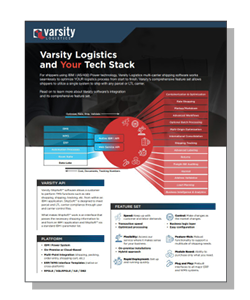
5 Ways Online Holiday Shopping is Affecting Your Supply Chain
Discover how the upcoming holiday shopping season will affect your supply chain and how advanced shipping software can help
The holiday season has always been a busy time for both retailers and shoppers, but in recent years, the landscape has shifted dramatically. With the rise of e-commerce, online shopping has become a central part of holiday preparations, transforming how consumers purchase everything from gifts to decorations and more. Just last year, 2023 holiday sales in the U.S. grew 3.8% to a record amount of $964.4 billion. This shift isn’t just changing how people shop; it’s redefining the entire supply chain.
In 2024, 20.1% of all retail purchases are expected to take place online, with 34% of shoppers making online purchases at least once a week. As more consumers opt for the convenience of online shopping during the holidays, the effects are felt across logistics and distribution networks that keep products moving. The growing dependence on e-commerce presents both challenges and opportunities for businesses, making it essential to understand how these shifts impact the supply chain.
5 Ways Your Supply Chain is Affected by Online Holiday Shopping
As shoppers increasingly rely on e-commerce to fulfill their holiday needs, businesses are faced with a set of unique challenges that require strategic adaptations and innovations. To better prepare supply chain professionals for the upcoming peak season, let’s explore five critical ways that online holiday shopping is impacting the supply chain.
1. Holiday Shopping is Starting Earlier
In recent years, the holiday shopping season has steadily crept earlier on the calendar. What used to begin around the November shopping holiday, Black Friday, is now in full swing by October. According to a survey following last year’s holiday season, 50% of U.S. consumers planned to begin their holiday shopping in October of 2023. Consumer demand for earlier deals also plays a part, as many shoppers prefer more time to spread out their holiday purchases.
For the supply chain, this extended holiday shopping window presents both opportunities and challenges. While an earlier start can help level out demand, reducing the risk of overwhelming peak seasons, it also complicates forecasting. This forces businesses to adapt to longer periods of sustained activity, ensuring they have the right amount of stock and resources on hand for a season that’s less predictable than ever. Failure to do so can be detrimental.
The earlier shopping season also heightens competition among retailers, pushing them to promise higher, earlier discounts than the retailer before them. This intensifies the importance of top-notch preparation and fulfillment strategies for these businesses. With customers shopping earlier, retailers must be ready to meet their demands sooner, requiring a more agile and responsive supply chain to stay competitive.
2. Promotions are Being Offered Earlier
It only makes sense that an earlier holiday shopping season is followed by earlier holiday promotions, and that is what we’re seeing. Most major retailers are increasingly launching their holiday campaigns earlier every year with messaging that encourages shoppers to “beat the rush” or gain “early access” to deals. Flash sales, early Black Friday deals, and extended promotional periods have also become the norm for businesses looking to capture consumers’ attention, prompting them to start their shopping before they historically might have.
Social media holds major influence over online retail, as 74% of U.S Gen Z’s use TikTok for searching. Large online retailers rely heavily on social media influence for deals such as Amazon’s Prime Day, who saw an 11.1% increase in revenue due to social. And having access to hundreds of thousands of stores through your device, constantly promoting coupon codes and significant savings, at any time of day, makes online holiday shopping hard to resist.
However, when promotions begin early, it causes demand to spike sooner than anticipated by supply chain professionals, forcing them to adjust quickly. Trying to account for sudden increases in orders while also preparing for the traditional peak season rush can make inventory planning highly difficult. Furthermore, earlier promotions mean retailers need to have stock available and fulfillment systems in place earlier, reducing the time to build up inventory before the peak season.
It is necessary for the supply chain to be flexible and adaptive to handle the shift in earlier deals and keep up with ever-changing consumer behaviors. Businesses must have a solid understanding of promotional timing and its impact on logistics – without it, they risk stockouts, shipping delays, and unhappy customers.
3. Increases in Volume and Pressure
With the rise of e-commerce, more consumers turn to online shopping for their holiday purchases, causing the sheer volume of orders to skyrocket during peak season. The surge of orders creates significant pressure across the supply chain, from inventory management to fulfillment and shipping operations. Both retailers and logistics providers are tasked with handling a higher volume of packages while maintaining speed and accuracy in the shipping process at the same time.
At the same time, a significant increase in orders can cause operational bottlenecks in distribution centers and transportation networks that aren’t equipped to process and deliver an overwhelming number of packages in a short timeframe. This can result in delays, fulfillment errors, and increase operational costs. Yet, retailers are still expected to meet increased volumes, while maintaining efficiency and accuracy, ensuring that customer expectations are met.
Consumers also expect faster delivery times as options like overnight, 1-day, and 2-day shipping have become more widely available. This increases the pressure on the supply chain because regardless of climbing orders, consumers still expect their packages to arrive in a timely manner. Managing this spike in demand requires careful coordination, robust technology, and a strategic approach to scaling operations during peak shopping seasons.
4. Omnichannel is Changing the Speed of Shopping
As omnichannel retailing has grown over the years, it has transformed how consumers shop during the holiday season. Shoppers now expect a seamless experience across online platforms, mobile apps, and physical stores, allowing them to browse, purchase, and receive products in a way that suits their individual preferences. Leading brands are driving this shift with innovative ways to integrate online and offline shopping experiences. For example, Target’s mobile app allows shoppers to check inventory by store location, provides item locations in store, enables consumers to buy online and pickup in-store (BOPIS), and more.
The intersection of mobile, e-commerce, and in-store purchasing not only provides consumers with more options, but it’s also accelerating the speed that they shop. However, this omni-channel shift presents new challenges for the supply chain. Inventory systems must be agile enough to respond to real-time demand across multiple channels, ensuring that products are available where and when customers need them. Fulfillment processes must also be highly capable of balancing the demand of online and in-store shopping. As these channels merge, the need for a responsive, well-coordinated supply chain has never been greater.
5. Complexity in Last-Mile Delivery
The last mile – the final move from the distribution center to the customer’s doorstep – is arguably the most crucial part of the delivery process. While this step is what transforms an online object into a tangible reality, it’s also where some of the greatest inefficiencies and obstacles arise. Increased order volumes, tighter delivery windows, and rising customer expectations for faster, more affordable shipping have all added layers of complexity to this stage of the logistics process.
Urban congestion, remote delivery locations, and the immense diversity of delivery destinations present a significant challenge for carriers trying to optimize their routes and meet deadlines. As consumers continue to expect same-day or next-day deliveries, it chips away at the time allotted for fulfillment. For businesses to meet the growing demand for speed, it is necessary they’re equipped with tools that can provide highly efficient routing, flexible delivery options, and real-time communication with customers to prevent delays, missed deliveries, and dissatisfaction.
When it comes to the last mile, the most important thing is finding a balance between cost, efficiency, and customer satisfaction. The businesses that can adapt quickly and effectively to these shifts in demand will put themselves in a better position to meet the growing expectations of the modern consumer and the holiday shopping season.
How Multi-Carrier Shipping Software Can Help
As the holiday shopping season continues to move earlier, volume continues to increase, consumer expectations continue to grow, and last-mile complexities remain, the challenges of peak season require more than traditional shipping methods. An advanced shipping solution like comprehensive multi-carrier shipping software plays a crucial role in helping businesses navigate the complexities of modern logistics with unmatched efficiency and flexibility.
Navigating Peak with Ease with Varsity Logistics
Having a reliable shipping solution is critical to maintaining smooth operations. Varsity Logistics, a top tier multi-carrier shipping software suite for shippers on IBM i (AS/400) Power systems, is designed to help high-volume shippers seamlessly navigate peak seasons. Varsity integrates seamlessly with all major IBM i enterprise resource planning (ERP) systems, warehouse management systems (WMS), and home-grown systems. This allows retailers to automate their shipping processes, manage carrier selection, and optimize costs across each platform without compromising speed or accuracy.
Varsity’s software suite equips shippers with advanced ShipSoft-Parcel and ShipSoft-Freight modules that will:
- Simplify Carrier Management: Varsity automates the carrier selection process by enabling shippers to leverage rate shopping across multiple parcel and LTL carriers based on various criteria such as transit time and carrier preference. This ensures businesses can always choose the most cost-effective and timely options for each shipment, even when facing the high demands of peak season. [Learn more about Varsity’s carrier selection process].
- Enhance Flexibility and Scalability: Varsity’s software is built to scale quickly to meet increased demand. The platform’s flexibility allows businesses to handle fluctuating shipping volumes effortlessly, ensuring that operations run smoothly no matter how high the holiday rush may be. [Discover how Varsity streamlines increased parcel throughput].
- Improve Last-Mile Delivery Performance: Varsity offers optimized routing, automated decision-making capabilities, and real-time tracking, enabling businesses to efficiently manage deliveries across different regions and ensure timely arrival. This lowers last-mile costs, results in faster deliveries, and improves customer satisfaction. [Read more about Varsity’s real-time communication functionality].
A lot goes into planning for the rush of the holiday season. Don’t go at it alone. Reach out to our expert team or schedule a pressure-free demo from a Varsity Shipping Specialist to learn how Varsity multi-carrier shipping software can optimize your supply chain logistics for peak holiday shipping success and beyond.










